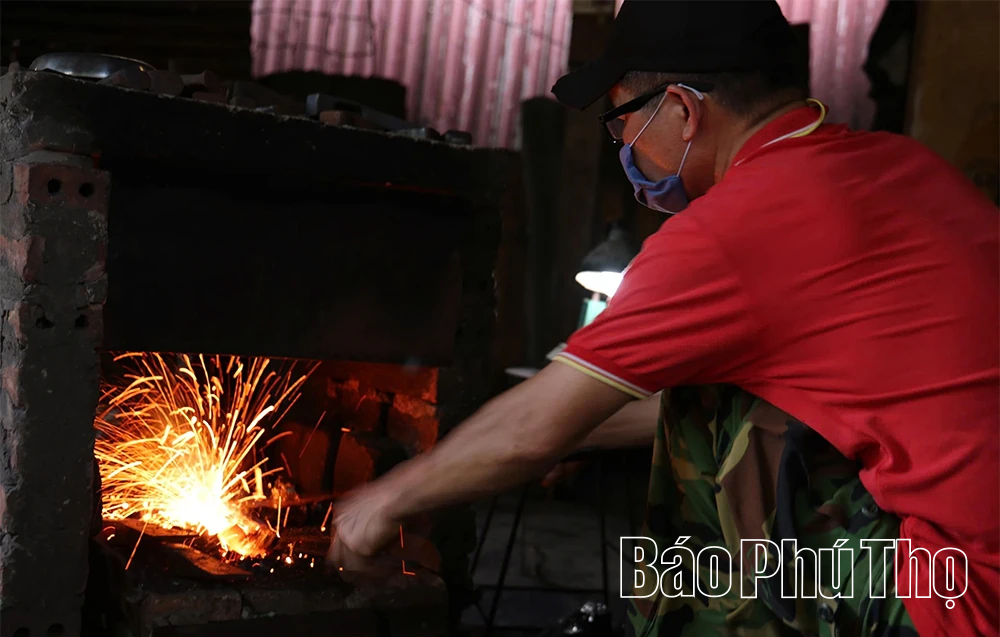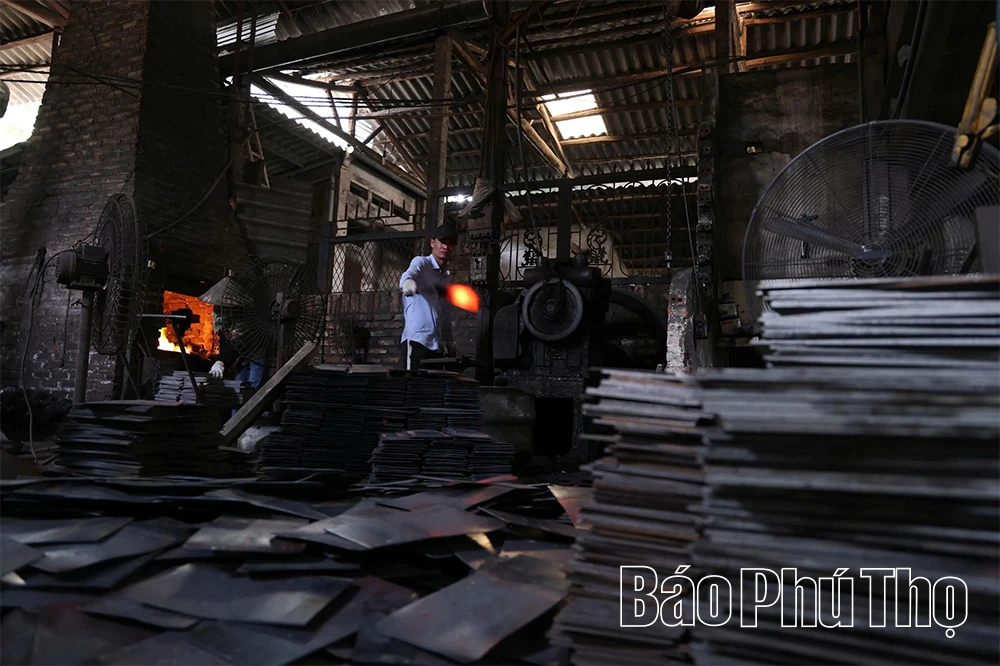The blacksmithing profession in Ly Nhan is said to have started from a sentimental anecdote. Legend has it that when this land was still poor, a mandarin passed by and saw the people in dire straits. He immediately built a furnace and invited skilled craftsmen to teach the craft to the people. Since then, the blacksmithing fire took root and burned brightly through many generations, becoming the livelihood and pride of the people here.
In the sweltering summer sun, the fires in the forges in Ban Mach village, Vinh Tuong commune are still blazing red.
In a low-roofed three-room house, the heat is as hot as a furnace, artisan Nguyen Van Trong, over 70 years old, is still working hard at the forge. His brown shirt is soaked with sweat, his hands still strike down with each hammer blow decisively and firmly. In front of him, a slicing knife blade is gradually taking shape under each iron anvil. Mr. Trong said: “I have been working since morning and I am already wet as a bath, but it is the peak season, so I can’t rest. On average, I can only forge about 7-8 knives a day, mainly kitchen knives, chopping knives, and playing knives. Although the market is full of cheaper industrial products, customers still prefer hand-forged knives. Because forged knives are durable, sharp, and heavy in the hand, not soulless mass-produced products.”
Not only Mr. Trong’s forge, the whole Ban Mach village these days is no different from a “big workshop”. Along the village road, everywhere you can hear the sound of punching machines, grinding machines, the sound of fire when steel meets hot coal. The workers are sweating profusely, many people work continuously from dawn to late at night but still cannot finish the orders.
In a larger workshop, Nguyen Van Dung, 38, was inspecting the newly invested steel rolling machine, speaking above the loud noise of the machine: “Manual work cannot meet the production capacity anymore, we have to bring in machines. But the soul of the profession still depends on the craftsman’s skills. Although machines support the steel tempering and knife sharpening stages, only the craftsman’s hands can determine the final quality.”
Blacksmiths of Ly Nhan village are always meticulous in every detail to create quality products.
According to statistics, the whole commune currently has more than 670 households engaged in blacksmithing with about 1,400 regular workers. On average, each day, the village supplies the market with 20,000 - 30,000 products, from knives, scissors, hoes, shovels to axe blades. The income of each household usually reaches from 500,000 to 1 million VND per day - a not small number in the countryside. Thanks to blacksmithing, many families have become well-off, and young people in the village have stable jobs and no longer have to go far away to make a living.
Workers say that from late autumn onwards is the busiest time. The whole village works day and night to meet orders for Tet - the peak shopping season of the year. At that time, Ban Mach is red with fire from morning to night, bustling with the sound of hammers, the whole village seems to not sleep.
Products of Ly Nhan forging village have affirmed their brand in domestic and foreign markets.
To meet the growing demand, many families have boldly invested in hundreds of machines, from hammers, rolling mills, punching machines to modern furnaces. Mechanization helps increase productivity many times over traditional manual work, while reducing the hardship and fatigue for workers, but the essence of the profession still lies in the hands of the blacksmith to create the difference between industrial products and products with the soul of the craft village.
Facing fierce competition from foreign goods, the products of Ly Nhan blacksmith village still maintain their own position in the market today. Ban Mach's knives, scissors, hoes, shovels, sickles, spears... are not only present in all the northern mountainous provinces and the Mekong Delta but also expanded to Laos and Cambodia. The locality has also established a Craft Village Association to share experiences, help each other, and cultivate knowledge to help the craft village develop more and more sustainably, continue to reach out and expand the market.
Le Minh
Source: https://baophutho.vn/lang-ren-ly-nhan-giu-hon-nghe-trong-nhip-song-hien-dai-238324.htm




























![[Photo] An Phu intersection project connecting Ho Chi Minh City-Long Thanh-Dau Giay expressway behind schedule](https://vstatic.vietnam.vn/vietnam/resource/IMAGE/2025/8/21/1ad80e9dd8944150bb72e6c49ecc7e08)






































![[Photo] Politburo works with the Standing Committee of Hanoi Party Committee and Ho Chi Minh City Party Committee](https://vstatic.vietnam.vn/vietnam/resource/IMAGE/2025/8/21/4f3460337a6045e7847d50d38704355d)

































Comment (0)